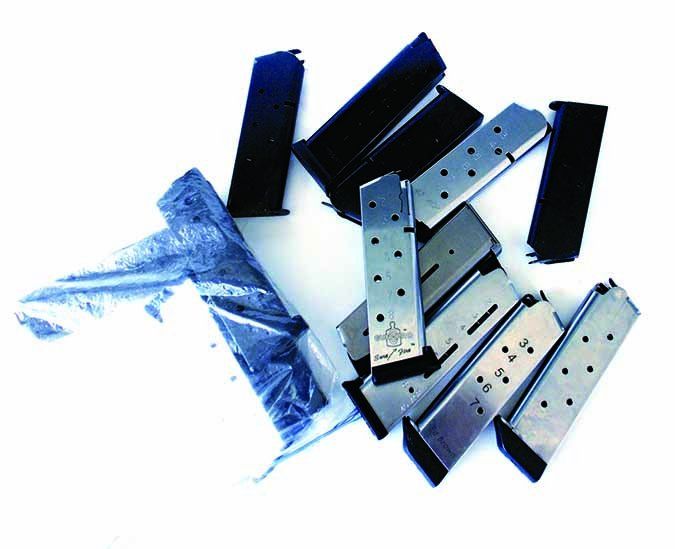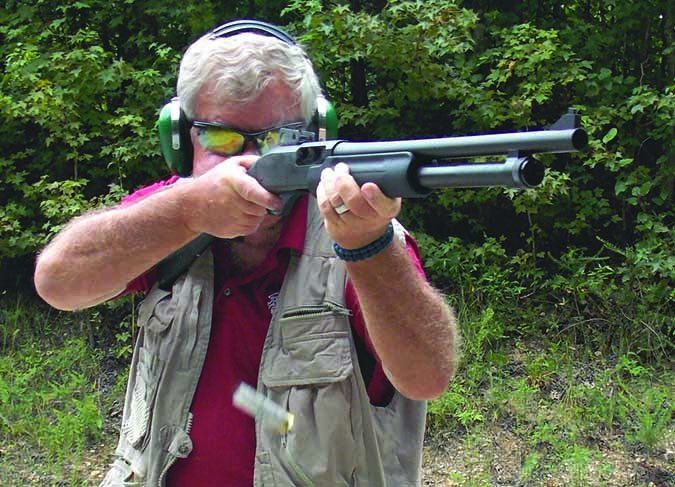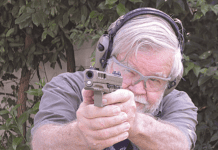Re: “1911 Mags: Some Are Good, And Some Should Be Avoided,” October 2016
Thanks for the evaluation of 1911 mags. It was quite comprehensive and good information, as usual. I own five 45 Commanders and two Government models, and I have settled on the Colt 8-round magazines as a standard for all. I picked those primarily because of the flush base. I love having nine rounds in the carry gun, but I don’t like an extra quarter inch or so extending beyond the grip. Previously, I used Wilson Combat mags because all the guys coming through my classes that shot Kimbers said they had to use Wilson mags with them to make them work reliably. Funny, huh?

I never thought of a drop test. I did drop a couple of my Colt mags yesterday and nothing popped out. By the way, I’m using the Ruger/Polycase ARX rounds, and so far I have had no feeding issues except one in the S&W 1911 SCE Commander. The most expensive 1911 I’ve got, and it’s the one that sometimes hiccups.
— David Freeman,Texas Gun Pros
Re: “Home-Defense Shotguns: We Compare Three Pump Actions,” October 2016
Gentlemen: As always, it is such a pleasure to read your publication each month. I would like to add a comment about your recent article on defensive pump guns. Being a professional sporting clays instructor, I prefer the shotgun to have only a bead and no rear sights.
Adding a rear sight and a front post are nice and definitely an advantage for longer-range stationary targets. However, I am convinced that if I need my shotgun for personal defense, the target will probably be close and possibly moving. So that’s a factor to consider as well.
Aiming, instead of pointing, at a dynamic moving target is not ideal. Also, the idea of adding a red-dot sight for self-defense is not something I would recommend. You are now dependent on a mechanical device and a battery. Murphy’s Laws always come into play. Keep it simple and you’ll live to fight another day.
I do not at all disagree with your findings, and we could discuss my opinions for hours. There is no “absolute” when it comes to self-defense. However, there is one thing I feel you did overlook: The Remington 870 is made in the US of A. I will pay extra for that! Great magazine, best regards. — Chuck
Mr. Woodard: I just received the October issue and immediately devoured every page, as usual. I noted in the article on Home Defense Shotguns where a comment was made about having to endure, “Fun isn’t the word when firing full-power buckshot,” and that the extensive testing and firing was done over a couple days due to the effects of sharp recoil over and over.
I have a recommendation for your testers. Buy a Buffalo Arms recoil pad. It is wonderful in greatly reducing felt recoil with heavy loads and is available in small, medium, and large sizes to fit various chest sizes. A friend of mine and I were shooting my reproduction 1876 Winchester in 45-75 back a few months ago, and with the rifle’s curved steel buttplate, recoil is nasty. With the Buffalo Arms pad, I can run through 20 rounds without fatigue or anticipating the severe recoil. I shoot a Remington 375 H&H at the range occasionally, and even THAT beast is subdued.

All three sizes are $45 plus shipping, and well worth, it in my experience. You folks who have to run dozens upon dozens, or even a few hundred rounds, through test firearms really should have these available for your testing! They work! I am pushing 75 and am a tad more sensitive to recoil, but now I can blast away for a couple hours with no soreness or discomfort at all. Keep up the terrific work!
— Bill
Bill, that is a super tip. Thanks for the lead. — Todd Woodard
Interesting article, but I’ll still take my old Winchester Model 1300 Defender (reviewed in April 1997) over any of the three guns reviewed. I alternate 00 buck and slug loads in the 7-round magazine, using Remington’s reduced-recoil Tactical ammo. If the buckshot doesn’t stop Billy BadGuy, the 12-gauge slug sure will. Love the magazine; keep up the good work.
— Dave
Dave, you are right, the 1300 is a fine piece of machinery. For the folks who may not have been reading Gun Tests back then, here’s a recap of that review:
The Winchester Model 1300 Defender is a 12-gauge pump action shotgun intended for personal protection. It is available with a wooden or synthetic stock and a 18- or 24-inch barrel. Either barrel has a 3-inch chamber, a cylinder bore and a bead front sight. The gun’s extended magazine holds seven 2.75-inch shells or six 3-inch shells. Suggested retail price of this model $290.
For this test, we acquired a Model 1300 Defender with a wooden stock and an 18-inch barrel. Excluding the white bolt, all of its steel parts had a blued finish with a medium polish. The aluminum alloy receiver was a matte black, while the black plastic trigger guard had a low-glare finish. The barrel was held securely in place by the screw-on magazine cap. The rotary bolt locked solidly into the barrel. A small to moderate amount of play was noted in moving parts.
Of the shotguns in this test, the Winchester was the lightest, the shortest and the most evenly balanced. Consequently, we thought target acquisition was the fastest and pointing was the easiest. Shouldering was quick and natural.
We found the relatively wide comb afforded a comfortable cheek-to-stock fit with a good view of the sight. Shooters with large hands said the grooved 6-inch-long by 2.07-inch-wide forend seemed a bit short, but it provided sufficient gripping area and was slip resistant. Establishing a firm, comfortable grasp on the 1.44-inch-wide pistol grip wasn’t a problem. Although this model’s felt recoil was milder than that of a standard 12-gauge pump shotgun, recoil was the heaviest of the test.
This Winchester functioned flawlessly throughout the test. Inserting shells into the tubular magazine through the loading port in the underside of the receiver didn’t present any difficulties. Despite one hitch toward the end of the action’s rearward movement, the action cycled smoothly and easily. Fired hulls were consistently ejected about 4 feet to the right of the shooter.
Movement of the grooved 1/4-inch-wide trigger was, in our opinion, clean but heavy. After about 1/8-inch of slack, it released with 8 pounds of rearward pressure and had very little overtravel. The heavy pull weight made accurate slug placement harder, but it was of no consequence when firing buckshot.
For sighting, the Model 1300 Defender had a large brass bead without a base on the front of the barrel and a serrated 8 5/8-inch-long by 3/8-inch-wide groove on the top of the receiver. Our shooters felt this arrangement provided an adequate sighting reference when using buckshot, but slugs impacted about 6 inches higher than the point of aim at 25 yards.
As we mentioned, this 12-gauge shotgun was equipped with a cylinder bore choke. Using Federal Classic 00 (9 pellet) buckshot, it yielded well-distributed shot patterns that were more than satisfactory for defensive work. Three-shot groups produced with Remington 2 3/4-inch magnum Slugger 1-ounce rifled slugs averaged 3 3/4 inches at 25 yards. See the accompanying Performance Table for more information.
Bottom Line: We thought the Winchester Model 1300 Defender’s workmanship, handling and functioning were satisfactory for a defensive shotgun that sells for under $300. Our shooters gave this one a thumbs up. — tw
Slide-Racking Effort
You probably get this question a lot, but I’m a new (first-year) subscriber and haven’t seen an answer. Is there any reliable way to measure the amount of force needed to rack the slide on semi-automatic pistols? New shooters — like my wife — frequently have trouble with the strong springs used on certain manufacturers’ products, and a good method to measure this and publish the results would be welcome. Thanks, and you have a great magazine. It has been very helpful in deciding what guns and accessories are the best for us! Regards.
— Dan
Hey Dan: We’ve struggled with this, but I believe the simplest way is to buy a small C clamp with leather shields on it, affix it to the serrated portion on the back of the slide, and use a fish-weighing scale to measure the effort. I’ve got two in my desk, one of which measures up to 25 pounds, and if the slide-racking effort is too much for that scale, then I’d give up. — tw
Re: “Big-Bore Snubnoses Around $500: Charter Arms and Taurus,” October 2016
I enjoyed this article and thought I’d throw in my two cents worth. I own a Charter Arms Bulldog 44 Model #64420 and find it to be quite accurate. The standard grip was changed to a Crimson Trace Laser Grip, which effectively softens the recoil of hotter ammo. One problem I’ve noticed with mine — which I also saw in a video about this revolver — is that unless the trigger is allowed to fully reset, the hand will spin the cylinder past the next chamber. Other than that, not a bad little gun, and less than $400!
— Dan
Inquiring About Canik
Do you plan on doing a test on the Canik TP9SF? Or have you had one in an issue that I don’t have? If so, could you point me to it or let me know if you plan on doing an in-depth story. Thanks for your magazine. I enjoy the material. Your friend in arms,
— Daniel
Sorry, we haven’t tested that Canik. We have tested the TP9SA, which is manufactured by Samsun Yurt Savunma, a Turkish gun maker, and imported by Century Arms of Delray Beach, Florida. The TP9SA and many of its accessories are marked “Canik,” for the Canik 55 division of the manufacturer. —tw





























